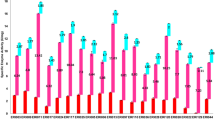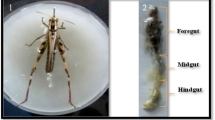Abstract
Thirteen cellulolytic bacteria were isolated, screened and characterized from the larval guts of grub beetle Phyllophaga sp. To delimit the growth of non-cellulolytic bacteria, the isolated bacteria were grown directly on selective medium containing Carboxymethyl cellulose (CMC) as sole carbon source. The potent cellulase producing isolate was further subjected to morphological, biochemical and molecular characterization. A gram positive, rod shaped motile isolate WGI4 showed maximum endonuclease (or CMCase) activity of 0.93 IU/ml and exonuclease (or FPase) activity of 1.8 IU/ml at temperature 37 °C and alkaline pH between 24 and 48 h of incubation. Based on 16S rRNA gene analysis the strain was found to be most closely related to Lysinibacillus sphaericus, L. cavernae, L. macroides (99.01%, 99.01%, 98.87% similarity, respectively) and identified as Lysinibacillus fusiformis. Further, the larvae gut was subjected to scanning electron microscopic study which revealed presence of abundant rod shaped bacteria firmly attached to the gut wall. To the best of our knowledge this is the first report of SEM study of white grub beetle Phyllophaga sp. larvae gut and isolation of a novel bacterial strain.






Similar content being viewed by others
Data Availability
(Data Transparency) Data used in this study are available from the author. The 16 S rRNA partial sequence of Lysinibacillus fusiformis strain WGI4 have been submitted at NCBI bearing accession number MZ_355626.1.
References
Bourtzis, K., and T.A. Miller, eds. 2003. Insect symbiosis, 1st ed. CRC Press. https://doi.org/10.1201/9780203009918.
Ariffin, H., N. Abdullah, K.M.S. Umi, Y. Shirai, and M.A. Hassan. 2006. Production and characterization of cellulase by Bacillus pumilus EB3. International Journal of Engineering and Technology 3 (1): 47–53 (Corpus ID: 28847637).
Butchanan, R.E., and N.E. Gibbons, (eds). 1974. Bergy’s manual of determinative bacteriology. 8th Edition, ed. Williams Wilkins Co., xxvi + 1246. Baltimore. https://doi.org/10.1111/j.1550-7408.1975.tb00935.x.
Cowan, S.T., and K.J. Steel. 1965. Manual for the identification of medical Bacteria. New York: Cambridge University Press. https://doi.org/10.1002/jobm.19670070114.
Dantur, I.K., R. Enrique, B. Welin, and A.P. Castagnaro. 2015. Isolation of cellulolytic bacteria from the intestine of Diatraea saccharalis larvae and evaluation of their capacity to degrade sugarcane biomass. AMB Express 5: 15. https://doi.org/10.1186/s13568-015-0101-z.
Dong, Z., F. Dou, Y. Yang, J.D. Wickham, R. Tang, Y. Zhang, X.H. Zhang, X.X. Wang, and W. Lu. 2020. First description and comparison of the morphological and ultramicro characteristics of the antennal sensilla of two fir longhorn beetles. Plos One 15 (10): e0241115. https://doi.org/10.1371/journal.pone.0241115.
Felsenstein, J. 1985. Confidence limits on phylogenies: An approach using the bootstrap. Evolution 39: 783–791.
Frago, E., M. Dicke, and H.C. Godfray. 2012. Insect symbionts as hidden players in insect–Plant interactions. Trends in Ecology and Evolution 27 (12): 705–711. https://doi.org/10.1016/j.tree.2012.08.013. (PMID: 22985943).
Gallegos-Monterrosa, R., S. Kankel, S. Götze, R. Barnett, P. Stallforth, and A.T. Kovács. 2017. Lysinibacillus fusiformis M5 induces increased complexity in Bacillus subtilis 168 colony biofilms via hypoxanthine. Journal of Bacteriology 199: e00204–e00217. https://doi.org/10.1128/JB.00204-17.
Ghose, T.K. 1987. Measurement of cellulase activities. Journal of Pure and Applied Chemistry 59 (2): 257–268. https://doi.org/10.1351/pac198759020257.
Gohel, H.R., C.N. Contractor, S.K. Ghosh, and V.J. Braganza. 2014. A comparative study of various staining techniques for determination of extra cellular cellulase activity on carboxy methyl cellulose (CMC) agar plates. International Journal of Current Microbiology and Applied Sciences 3 (5): 261–266.
He, M., X. Li, H. Liua, S.J. Millerc, and G. Wanga. 2011. Characterization and genomic analysis of a highly chromate resistant and reducing bacterial strain Lysinibacillus fusiformis ZC1. Journal of Hazardous Materials 185: 682–688. https://doi.org/10.1016/j.jhazmat.2010.09.072.
Hotopp, J.C.D., M.E. Clark, D.C. Oliveira, J.M. Foster, P. Fischer, M.C.M. Torres, J.D. Geibel, N. Kumar, N. Ishmael, S. Wang, J. Ingram, R.V. Nene, J. Shepard, J. Tomkins, S. Richards, Dj. Spiro, E. Ghedin, B.E. Slatko, H. Tettlin, and J.H. Werren. 2007. Wide spread lateral gene transfer from intracellular bacteria to multicellular eukaryotes. Science 317 (5845): 1753–1756. https://doi.org/10.1126/science.1142490. (PMID: 17761848).
Kalia, A., and M.S. Dhaniya. 2022. Evaluation of biodegradation efficiency of xylene pretreated polyethylene wastes by isolated Lysinibacillus fusiformis. Nature Environment and Pollution Technology 21 (3): 1375–1380. https://doi.org/10.46488/NEPT.2022.v21i03.045.
Lanyi, B. 1987. Classical and rapid identification methods for medically important bacteria. Methods in Microbiology 19: 1–67. https://doi.org/10.1016/S0580-9517(08)70407-0.
Lowry, O.H., N.J. Rosebrough, A.L. Farr, and R.J. Randall. 1951. Protein measurement with the folin phenol reagent. Journal of Biological Chemistry 193 (1): 265–275. https://doi.org/10.1016/S0021-9258(19)52451-6.
Mathivanan, K., J.U. Chandirika, A. Vinothkanna, R.K. Govindarajan, D. Meng, and H. Yin. 2021. Characterization and biotechnological functional activities of exopolysaccharides produced by Lysinibacillus fusiformis KMNTT–10. Journal of Polymers and the Environment 29: 1742–1751. https://doi.org/10.1007/s10924-020-01986-3.
Mathivanan, K., R. Rajaram, and G. Annadurai. 2018. Biosorption potential of Lysinibacillus fusiformis KMNTT-10 biomass in removing lead(II) from aqueous solutions. Separation Science and Technology 53 (13): 1991–2003. https://doi.org/10.1080/01496395.2018.1442863.
Miller, G.L. 1959. Use of dinitrosalicylic acid reagent for determination of reducing sugar. Analytical Chemistry 31 (3): 426–428. https://doi.org/10.1021/ac60147a030.
Montllor, C.B., A. Maxmen, and A.H. Purcell. 2002. Facultative bacterial endosymbionts benefit pea aphids Acyrthosiphon pisum under heat stress. Ecology Entomology 27: 189–195. https://doi.org/10.1046/j.1365-2311.2002.00393.x.
Moore, J. 2002. Parasites and the behavior of animals, 15. New York: Oxford University Press on Demand.
Nation, J.L. 1983. A new method using hexamethyldisilazane for preparation of soft insect tissues for scanning electron microscopy. Biotechnic and Histochemistry 58 (6): 347–351. https://doi.org/10.3109/10520298309066811.
Nei, M., and S. Kumar. 2000. Molecular evolution and phylogenetics. New York: Oxford University Press.
Niranjane, A.P., P. Madhou, and T.W. Stevenson. 2007. The effect of carbohydrate carbon sources on the production of cellulase by Phlebia Gigantean. Enzyme and Microbial Technology 40 (6): 1464–1468. https://doi.org/10.1016/j.enzmictec.2006.10.041.
Nucleotide [Internet]. Bethesda (MD). : National Library of Medicine (US), National Center for Biotechnology In-formation; [1988]-. Accession No. MZ_355626.1, Lysinibacillus fusiformis strain WGI4 16S ribosomal RNA gene, partial sequence GenBank: MZ355626.1. https://www.ncbi.nlm.nih.gov/nuccore/mz355626.Accessed 12 June 2021
Ojumu, T.V., O.B. Solomon, E. Betiku, S.K. Layokun, and B. Amigun. 2003. Cellulase production by Aspergillus flavus Linn. isolate NSPR 101 fermented in sawdust, bagasse and corncob. African Journal of Biotechnology 2 (6): 150–152. https://doi.org/10.5897/AJB2003.000-1030.
Park, S.J., Y.M. Park, W.Y. Chun, W.J. Kim, and S.Y. Ghim. 2010. Calcite-forming bacteria for compressive strength improvement in Mortar. Journal of Microbiology and Biotechnology 20 (4): 782–788. https://doi.org/10.4014/jmb.0911.11015.
Passera, A., M. Rossato, J.S. Oliver, G. Battelli, G.I.R. Shahzad, E. Cosentino, J.M. Sage, S.L. Toffolatti, G. Lopatriello, J.R. Davis, M.D. Kaiser, M. Delledonne, and P. Casati. 2021. Characterization of Lysinibacillus fusiformis strain S4C11: In vitro, in planta, and in silico analyses reveal a plant-beneficial microbe. Microbiological Research 244: 126665. https://doi.org/10.1016/j.micres.2020.126665.
Pudova, D.S., M.T. Lutfullin, E.I. Shagimardanova, G.F. Hadieva, L. Shigapova, A.A. Toymentseva, D.A. Kabanov, A.M. Mardanova, S.G. Vologin, and M.R. Sharipova. 2018. Draft genome sequence data of Lysinibacillus fusiformis strain GM, isolated from potato phyllosphere as a potential probiotic. Data in Brief 21 (2018): 2504–2509. https://doi.org/10.1016/j.dib.2018.11.107.
Reinhard, H.J. 1940. The life history of Phyllophaga lanceolata (say) and Phyllophaga crinita Burmeister. Journal of Economic Entomology 33 (3): 572–578. https://doi.org/10.1093/jee/33.3.572.
Ritcher, P.O. 1958. Biology of scarabaeidae. Annual Review of Entomology 3: 311–334. https://doi.org/10.1146/annurev.en.03.010158.001523.
Romero-López, A.A., A. René, J. Valdez, M.A. Moron, V. Castrejón-Gómez, and F.C. Villalobos. 2004. Sensory organs in the antennae of Phyllophaga obsoleta (Coleoptera: Melolonthidae). Annals of the Entomological Society of America 97 (6): 1306–1312. https://doi.org/10.1603/0013-8746(2004)097[1306:SOITAO]2.0.CO;2.
Saitou, N., and M. Nei. 1987. The neighbor-joining method: a new method for reconstructing phylogenetic trees. Molecular Biology and Evolution 4 (4): 406–425. https://doi.org/10.1093/oxfordjournals.molbev.a040454.
Sari, I.P., and K. Simarani. 2019. Decolorization of selected azo dye by Lysinibacillus fusiformis W1B6: Biodegradation optimization, isotherm, and kinetic study biosorption mechanism. Adsorption Science & Technology 37 (5–6): 492–508. https://doi.org/10.1177/0263617419848897.
Siddiqui, J.A., M.M. Khan, B.S. Bamisile, M. Hafeez, M. Qasim, M.T. Rasheed, M.A. Rasheed, S. Ahmad, M.I. Shahi, and Y. Xu. 2022. role of insect gut microbiota in pesticide degradation: A review. Frontiers in Microbiology 3 (13): 870462. https://doi.org/10.3389/fmicb.2022.870462.
Su, Q., X. Zhou, and Y. Zhang. 2013. Symbiont-mediated functions in insect hosts. Communicative & Integrative Biology 6 (3): e23804. https://doi.org/10.4161/cib.23804.
Taieb, I., S. Ben Younes, B. Messai, S. Mnif, R. Mzoughi, A. Bakhrouf, C. Jabeur, J.A. Ayala Serrano, and A. Ellafi. 2021. Isolation, characterization and identification of a new Lysinibacillus fusiformis strain ZC from Metlaoui phosphate laundries wastewater: Bio-treatment assays. Sustainability 13: 10072. https://doi.org/10.3390/su131810072.
Tamura, K., G. Stecher, and S. Kumar. 2021. MEGA 11: Molecular evolutionary genetics analysis version 11. Molecular Biology and Evolution. https://doi.org/10.1093/molbev/msab120.
Teather, R.M., and P.J. Wood. 1984. Use of Congo red-polysac-charide interactions in enumeration and characterization of cellulolytic bacteria from the bovine rumen. Journal of Applied and Environmental Microbiology 43 (4): 777–780. https://doi.org/10.1128/aem.43.4.777-780.1982.
Vorburger, C., L. Gehrer, and P. Rodriguez. 2010. A strain of the bacterial symbionts Regiella insecticola protects aphids against parasitoids. Biology Letters 6 (1): 109–111. https://doi.org/10.1098/rsbl.2009.0642. (PMID: 19776066).
Watschke, T.L., P.H. Dernoeden, and D.J. Shetlar. 1995. Managing turfgrass pests, 361. Boca Raton: Lewis Publishers.
White, R.A., M. Agosin, R.T. Franklin, and J.W. Webb. 1980. Bark beetle pheromones: Evidence for physiological syn-thesis mechanisms and their ecological implications. Zeitschrift fur Angewandte Entomologie 90 (1–5): 255–274. https://doi.org/10.1111/j.1439-0418.1980.tb03526.x.
Woodruff, R. E., and B. M. Beck. 1989. The scarab beetles of Florida (Coleoptera: Scarabaeidae) Part II. In Arthropods of Florida and neighboring land areas, vol. 13 225. Gainesville, FL: Florida Department of agriculture and consumer services, Division of Plant Industry.
Zhu, L., J. Guo, Y. Sun, S. Wang, and C. Zhou. 2021. Acetic acid-producing endophyte Lysinibacillus fusiformis orchestrates Jasmonic acid signaling and contributes to repression of cadmium uptake in tomato plants. Frontiers. Plant Science 12: 670216. https://doi.org/10.3389/fpls.2021.670216.
Acknowledgements
The authors are grateful to Microbial Type Culture Collection and Gene Bank (MTCC), CSIR Institute of Microbial Technology, Chandigarh, India for timely identification of the bacterial isolate WGI4, and to the Botanical Survey of India, Eastern Regional Centre, Shillong, Meghalaya, India for providing Scanning Electron Microscope (SEM) facility.
Funding
This research received no external funding.
Author information
Authors and Affiliations
Contributions
DP and AB: conceptualization, supervision, review and editing. SB: investigation and formal analysis, experiments, and analysis of results, writing original draft.
Corresponding author
Ethics declarations
Conflict of interest
The authors declare that they have no competing interests.
Consent for Publication
All the authors of the manuscript have unanimously agreed and given their consent to publish this article to your journal.
Additional information
Publisher’s Note
Springer Nature remains neutral with regard to jurisdictional claims in published maps and institutional affiliations.
Supplementary Information
Below is the link to the electronic supplementary material.
Rights and permissions
Springer Nature or its licensor (e.g. a society or other partner) holds exclusive rights to this article under a publishing agreement with the author(s) or other rightsholder(s); author self-archiving of the accepted manuscript version of this article is solely governed by the terms of such publishing agreement and applicable law.
About this article
Cite this article
Biswas, S., Paul, D. & Bhattacharjee, A. Cellulolytic Potential of Lysinibacillus fusiformis Strain WGI4 Isolated From White Grub Beetle Phyllophaga sp. (Coleoptera: Scarabaeidae) Larvae Gut. Proc Zool Soc 77, 116–125 (2024). https://doi.org/10.1007/s12595-024-00514-8
Received:
Revised:
Accepted:
Published:
Issue Date:
DOI: https://doi.org/10.1007/s12595-024-00514-8




